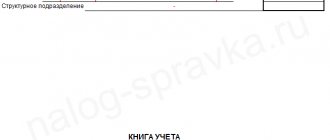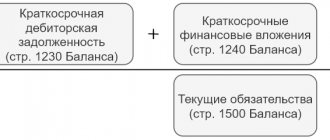What's behind the balance sheets?
Below is a complete breakdown of the balance sheet lines for 2018/2019. Moreover, each line is specified according to the most characteristic accounts for it, which are reflected in it. Of course, the specifics of economic activity in practice may leave their mark on this correspondence.
Also, the order of formation of accounting reports, as well as the reflection of certain indicators, is influenced by the accounting policy for accounting purposes adopted by the company.
The following is a breakdown of the balance sheet lines for the accounts in two tables - by asset and liability of the balance sheet.
REFLECTION OF VAT IN ACCOUNTING REPORTS
– goods have been capitalized.
Dt19 Kt60
53389.83 rubles – input VAT accepted.
During the analysis of demand, the LLC decided to transfer part of the batch to a retail store, the activities of which are on UTII. A shipment worth 100,000 rubles was transferred (including VAT 18% - 15,254.24 rubles).
Since activities under UTII are not subject to VAT, the amount of input tax cannot be deducted. Only VAT on taxable activities is accepted for deduction:
Dt68 Kt19
RUB 38,135.59 - accepted for deduction.
Dt9.2 Kt19
RUB 15,254.24 – VAT on UTII is included in other costs.
Explanation of lines for balance sheet assets
| Indicator name | Code | Which account data is used? | Algorithm for calculating the indicator |
| Intangible assets | 1110 | 04 “Intangible assets”, 05 “Amortization of intangible assets” | Dt 04 (excluding R&D expenses) – Kt 05 |
| Research and development results | 1120 | 04 | Dt 04 (in terms of R&D expenses) |
| Intangible search assets | 1130 | 08 “Investments in non-current assets”, 05 | Dt 08 – Kt 05 (all regarding intangible exploration assets) |
| Material prospecting assets | 1140 | 08, 02 “Depreciation of fixed assets” | Dt 08 – Kt 02 (all regarding material exploration assets) |
| Fixed assets | 1150 | 01 “Fixed assets”, 02 | Dt 01 – Kt 02 (except for depreciation of fixed assets accounted for in account 03 “Income-generating investments in tangible assets” |
| Profitable investments in material assets | 1160 | 03, 02 | Dt 03 – Kt 02 (except for depreciation of fixed assets accounted for on account 01) |
| Financial investments | 1170 | 58 “Financial investments”, 55-3 “Deposit accounts”, 59 “Provisions for impairment of financial investments”, 73-1 “Settlements on loans provided” | Dt 58 – Kt 59 (regarding long-term financial investments) + Dt 73-1 (regarding long-term interest-bearing loans) |
| Deferred tax assets | 1180 | 09 “Deferred tax assets” | Dt 09 |
| Other noncurrent assets | 1190 | 07 “Equipment for installation”, 08, 97 “Deferred expenses” | Dt 07 + Dt 08 (except for exploration assets) + Dt 97 (in terms of expenses with a write-off period of more than 12 months after the reporting date) |
| Reserves | 1210 | 10 “Materials”, 11 “Animals for growing and fattening”, 14 “Reserves for reducing the cost of material assets”, 15 “Procurement and acquisition of material assets”, 16 “Deviation in the cost of material assets”, 20 “Main production”, 21 “Semi-finished products own production”, 23 “Auxiliary production”, 28 “Defects in production”, 29 “Service production and facilities”, 41 “Goods”, 42 “Trade margin”, 43 “Finished products”, 44 “Sales expenses”, 45 “Goods shipped”, 97 | Dt 10 + Dt 11 – Kt 14 + Dt 15 + Dt 16 + Dt 20 + Dt 21 + Dt 23 + Dt 28 + Dt 29 + Dt 41 – Kt 42 + Dt 43 + Dt 44 + Dt 45 + Dt 97 (in part expenses with a write-off period of no more than 12 months after the reporting date) |
| Value added tax on purchased assets | 1220 | 19 “Value added tax on acquired assets” | Dt 19 |
| Accounts receivable | 1230 | 46 “Completed stages of work in progress”, 60 “Settlements with suppliers and contractors”, 62 “Settlements with buyers and customers”, 63 “Provisions for doubtful debts”, 68 “Settlements for taxes and duties”, 69 “Settlements for social insurance and security", 70 "Settlements with personnel for wages", 71 "Settlements with accountable persons", 73 "Settlements with personnel for other operations", 75 "Settlements with founders", 76 "Settlements with various debtors and creditors" | Dt 46 + Dt 60 + Dt 62 – Kt 63 + Dt 68 + Dt 69 + Dt 70 + Dt 71 + Dt 73 (except for interest-bearing loans accounted for in subaccount 73-1) + Dt 75 + Dt 76 (less reflected in accounts for VAT calculations on advances issued and received) |
| Financial investments (excluding cash equivalents) | 1240 | 58, 55-3, 59, 73-1 | Dt 58 – Kt 59 (in terms of short-term financial investments) + Dt 55-3 + Dt 73-1 (in terms of short-term interest-bearing loans) |
| Cash and cash equivalents | 1250 | 50 “Cash”, 51 “Current accounts”, 52 “Currency accounts”, 55 “Special bank accounts”, 57 “Transfers in transit”, | Dt 50 (except for subaccount 50-3) + Dt 51 + Dt 52 + Dt 55 (except for the balance of subaccount 55-3) + Dt 57 |
| Other current assets | 1260 | 50-3 “Money documents”, 94 “Shortages and losses from damage to valuables” | Dt 50-3 + Dt 94 |
The procedure for reflecting revenue with and without VAT in the financial results statement: Form 2, balance sheet, postings
But it is not always possible to bring the data together. Let us pay attention to one significant difference between the rules of PBU 2/2008 and Art. 271 Tax Code of the Russian Federation. The procedure for recognizing revenue using the “as ready” method, provided for by PBU 2/2008, applies to all contracts subject to this PBU, regardless of whether the contract provides for phased delivery of work or not. At the same time, the procedure for recognizing revenue provided for in Art. 271 of the Tax Code of the Russian Federation, applies only to those contracts that do not provide for phased delivery of work.
Recognition of revenue in accordance with the requirements of PBU 2/2008 2009 Since 2009, when organizing income accounting, it is necessary to take into account the requirements of PBU 2/2008 “Accounting for construction contracts”. The norms of PBU 2/2008 are addressed to organizations that are executors under the contracts listed in paragraph.
1 and 2 PBU 2/2008 (see p. 215). Moreover, the contracts listed in these paragraphs are subject to PBU 2/2008 only if they are long-term in nature (last more than one reporting year) or their start and end dates fall on different reporting years. ! If the contract began and ended in the same reporting year, then the rules established by PBU 2/2008 do not apply to it. PBU 4/99 “Accounting statements of an organization” (approved by order of the Ministry of Finance of the Russian Federation dated July 6, 1999 No. 43n). This can be done by adding lines 12201, 12202, etc.
d. Detailing is possible in the context of operations (acquisition) of fixed assets, inventories, intangible assets and others. Standardized expenses The debit balance on account 19 can also be formed when paying expenses that are normalized when calculating income tax.
Thus, there are expenses that cannot be fully taken into account in the tax base when calculating income tax. Read about what expenses are regulated and what the limits for rationing are in the material “Standards provided for by the Tax Code of the Russian Federation.”
Hand in hand, taking into account standardized expenses, comes the problem of deducting value added tax. That is, if these expenses are normalized, then the right to deduct VAT on them is also curtailed.
At the same time, PBU 2/2008 offers two possible options: 1) according to the share of the volume of work performed as of the reporting date in the total volume of work under the contract (for example, by expert assessment of the volume of work performed or by calculating the share of the volume of work performed in physical terms ( in kilometers of roadway, cubic meters of concrete, etc.) in the total scope of work under the contract); 2) by the share of expenses incurred as of the reporting date in the estimated value of total expenses under the contract (for example, by calculating the share of expenses incurred in physical and monetary terms in the estimated value of total expenses under the contract in the same meter). So, the general idea of PBU 2/2008 is this.
Decoding lines for balance sheet liabilities
| Index | Code | Which account data does it use? | Algorithm for calculating the indicator |
| Authorized capital (share capital, authorized capital, contributions of partners) | 1310 | 80 “Authorized capital” | Kt 80 |
| Own shares purchased from shareholders | 1320 | 81 “Own shares (shares)” | Dt 81 (in parentheses) |
| Revaluation of non-current assets | 1340 | 83 “Additional capital” | Kt 83 (regarding the amounts of additional valuation of non-current assets) |
| Additional capital (without revaluation) | 1350 | 83 | Kt 83 (except for amounts of additional valuation of non-current assets) |
| Reserve capital | 1360 | 82 “Reserve capital” | Kt 82 |
| Retained earnings (uncovered loss) | 1370 | 99 “Profits and losses”, 84 “Retained earnings (uncovered loss)” | Or Kt 99 + Kt 84 Or Dt 99 + Dt 84 (the result is reflected in parentheses) Or Kt 84 - Dt 99 (if the value is negative, it is reflected in parentheses) Or Kt 99 - Dt 84 (same) |
| Borrowed funds | 1410 | 67 “Calculations for long-term loans and borrowings” | Kt 67 (regarding debts with a maturity date of more than 12 months at the reporting date) |
| Deferred tax liabilities | 1420 | 77 “Deferred tax liabilities” | Kt 77 |
| Estimated liabilities | 1430 | 96 “Reserves for future expenses” | Kt 96 (regarding estimated liabilities with a maturity period of more than 12 months after the reporting date) |
| Other obligations | 1450 | 60, 62, 68, 69, 76, 86 “Targeted financing” | Kt 60 + Kt 62 + Kt 68 + Kt 69 + Kt 76 + K86 (all in terms of long-term debt) |
| Borrowed funds | 1510 | 66 “Calculations for short-term loans and borrowings”, 67 | Kt 66 + Kt 67 (in terms of debt with a repayment period of no more than 12 months as of the reporting date) |
| Accounts payable | 1520 | 60, 62, 68, 69, 70, 71, 73, 75, 76 | Kt 60 + Kt 62 + Kt 68 + Kt 69 + Kt 70 + Kt 71 + Kt 73 + Kt 75 + Kt 76 (in terms of short-term debt, minus VAT calculations reflected in the accounts on advances issued and received) |
| revenue of the future periods | 1530 | 98 “Deferred income” | Kt 98 |
| Estimated liabilities | 1540 | 96 | Kt 96 (regarding estimated liabilities with a maturity period of no more than 12 months after the reporting date) |
| Other obligations | 1550 | 86 | Kt 86 (regarding short-term liabilities) |
Read also
31.07.2018
A little about accounting account 19 for VAT accounting
In order to collect VAT on purchases, account 19 is used. Several sub-accounts are opened for it, which allow you to keep track of VAT analytics on goods, services, intangible assets and other types of purchases.
Such VAT is subject to reflection on account 19 and is accepted for deduction when calculating tax for the quarter.
In order for VAT amounts to be deducted, the following conditions must be met:
- The purchased property must be used in activities subject to VAT
- The company accountant has a correctly executed original invoice in his hands
- The purchased property is registered with the organization
In most cases, there is no balance on account 19. If at the end of the period a credit balance on the account is formed, this means using the opportunity to accept VAT for reimbursement.
If the organization has not received an invoice for the purchase, then after three years the tax amount is written off to account 91.
Questions on the topic under consideration
Question 1
The organization is on a simplified system. Is it necessary to fill out line 1220 when preparing annual reports?
Simplified people are a special type of taxpayers. As a rule, they do not work with VAT, however, they may have “input” VAT. In this regard, the company can establish in its accounting policy the provision that all VAT received with purchases is taken into account in account 19. In this situation, at the end of the period an account balance will be formed, and when drawing up the annual report, this balance will be transferred to line 1220.
Question 2
Can there be the same VAT amounts on lines 1220 and 1520 of the balance sheet?
No, they can't. The coincidence of the meaning of these lines is a pure coincidence, this is an error. Line 1220 is in the balance sheet asset and shows the tax on purchased assets that is not accepted for deduction. Line 1520 is in the liability side and reflects the company’s debt to the budget. There is probably no primary document for the purchase of goods. It is necessary to analyze and identify the error.
Reflecting VAT on the balance sheet is not as simple as it seems at first glance. Before drawing up the annual report, it is necessary to conduct a thorough check of all indicators, carry out reconciliations with counterparties, take into account the expenses that are accepted according to the standards, and only after that bring the information into the balance sheet. Since tax amounts can be reflected in both an asset and a liability, it is very important to understand which amount to report in which line. Line 1220 is not always filled in.




